Apec Water Reverse Osmosis Water Filtration User Guide
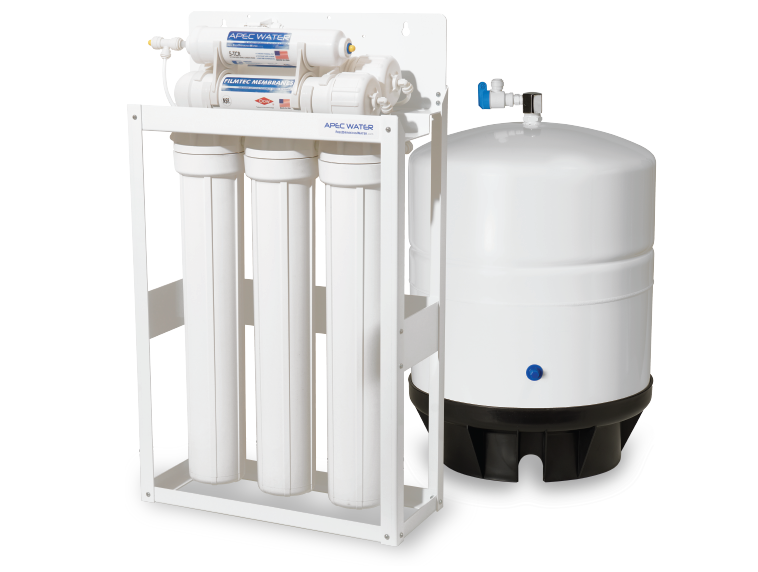
Content
APEC Water Reverse Osmosis Water Filtration Introduction
Filtration System is a top-tier solution for achieving clean and safe drinking water at home. Designed to eliminate over 1,000 contaminants, including heavy metals and harmful impurities, this system ensures superior filtration with a compact design ideal for any kitchen. Its advanced technology allows for a high production rate of 600 gallons per day while maintaining a 2:1 pure-to-waste water ratio. Priced around $299, it offers excellent value for those seeking reliable water purification.
Specifications
- Removes up to 99% of contaminants including chlorine, lead, fluoride, and more
- High-capacity filters with long-lasting performance
- Easy installation and maintenance
- Compact design suitable for under-sink installation
- Automatic shut-off valve to conserve water
- Lead-free chrome faucet included
- NSF certified for quality and safety
BEFORE INSTALLATION
Inspect the system:
Please take the system and all the components out of the box. Inspect the system and all the connection fittings carefully, make sure nothing is damaged during shipping. If any part is cracked or broken, please do not proceed with the installation and contact APEC or your distributor for an exchange or diagnosis.
Recommended tools list:
- Variable speed drill
- Drill bit- 1/4” (for the waste line), 1/8” (as pilot, not mandatory), and 1/2” (for faucet hole, if neces-sary)
- 5/8”, 9/16” open-end wrench, or adjustable wrench, pliers
- Phillips screwdriver
- Utility knife, or scissors
- Teflon tape
Operating Parameter
- Operating pressure: 85 psi maximum
- Feed water temperature: 40 – 100 degree F (4-37 degree C)
- Do not connect this unit to hot water source
- Protect the RO from freezing. Water freezing in the system will damage it.
- Install the RO in a sheltered environment, avoid exposure to hot and cold weather or under direct sun light.
General Installation/Operation/Maintenance Requirements
- Installation needs to comply with state and local laws and regulations.
- System must be installed indoor away from possible environmental damage
- Do not use with water that is microbiologically unsafe or of unknown quality without adequate disinfection before or after system. Systems certified for cyst reduction may be used on disinfected water that may contain filterable cysts.
- This reverse osmosis system contains a replaceable treatment component critical for effective reduction of total dissolved solids. The product water shall be tested periodically to verify that system is performing satisfactorily.
Components included with the Ro system

- 1 RO system
- 3 Pre-filters in 3 Housings
- 1 Storage tank
- 2 - 4 RO membranes (depends on model) Pre inserted in membrane housing
Installation Kit includes
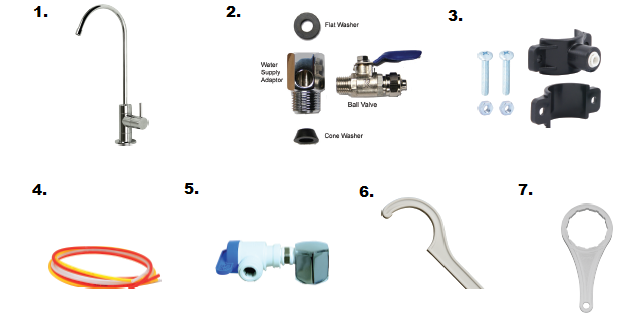
- 1 Faucet with washers, nuts and adapter
- 1 Feed water adaptor with feed water ball valve kit
- 1 Drain saddle for waste water
- Color tubings 3/8”
- 1 Tank shut-off valve with adaptor fitting
- 1 Wrench to open 3 pre-filter housing
- 1 Wrench to open membrane housings
Component Itemization
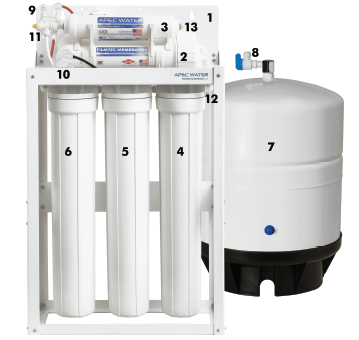
- Bracket
- Membranes inside their housings
- In-line carbon filter (last-stage filter)
- Sediment pre-filter and housing (1st stage filter)
- Carbon block pre-filter and housing (2nd- stage filter)
- Carbon block pre-filter and housing (3rd- stage filter)
- Storage tank
- Tank shut-off valve
- ASO
- Check valve
- T-fitting (Last-stage filter)
- Feed water inlet
- Filtered water outlet
Fitting Types
The Ro Lite Commercial System comes standard with Quick-Connect (QC) Fittings.
Quick-Connect (QC)
Fittings: (no insert, sleeve, or nut), most of the fittings on the RO unit are this type.
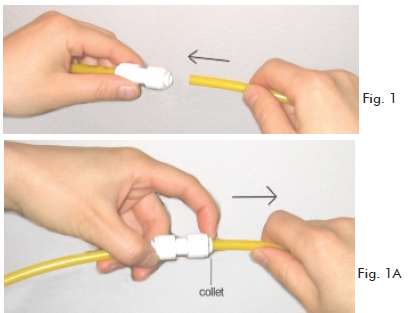
To connect:
See Fig.1
- Push the tubing into the Quick-Connect fitting tightly, gently pull back on the tubing to make sure connection was secure.
- No inserts, sleeve, or nuts are needed to secure the connection.
- No Teflon tape!
To disconnect:
See Fig.1A
- Push in and hold down on the collet ring around the base of the fitting, then pull out tubing.
Description
The APEC Water Reverse Osmosis Water Filtration system uses a multi-stage filtration process to ensure the highest quality of drinking water. It starts with a sediment filter to remove larger particles, followed by a carbon block filter to eliminate chlorine and other taste and odor impurities. The heart of the system is the reverse osmosis membrane, which removes the bulk of contaminants. Finally, a post-carbon filter polishes the water to enhance its taste and odor.
This system is designed to be efficient, using a minimal amount of wastewater compared to other RO systems on the market. It also comes with a lead-free chrome faucet that is easy to install and adds a touch of elegance to your kitchen.
INSTALLING THE SYSTEM
All filters are already pre-installed inside their housings, please follow the installation steps listed below.
The Ro Lite Commercial system can be installed in any location where there is a cold water supply with suffi-cient water pressure for your chosen RO model, and an outlet to drain off the waste water generated by the system. A sheltered environment is recommended to avoid any exposure to hot and cold weather or under direct sunlight.
Step 1: Feed Water Connection
The Ro system must be connected to the COLD water supply only!
The Ro’s feed water adaptor fits a 1/2” pipe. If you need to cut the pipe, using a qualified plumber is highly recommended.
The instructions below are for “under-sink” installation.
- For under-sink hook up: Locate the Cold water supply valve under the sink. Turn OFF the incoming cold water completely.
Note: If the cold water shut off valve is unable to turn off the water, the main water supply to the house must be shut off for the installation.
Be sure to use Teflon Tape on all metal connections to prevent leaks! For Flex Line Riser: See Fig. 2A. Loosen nut and separate cold water riser tube from faucet shank.
Gently bend riser tube so that the Feed Water Adapter (Fig.5) fits onto the faucet shank. Fit the new cone washer provided in the kit onto the riser tube. Connect the riser tube, the feed water adapter, and faucet shank together and tighten. Use Teflon tape on threaded parts to prevent leaks.
For Solid Copper Riser: See Fig. 2B. Follow the same procedure as for flex line. If the copper riser cannot bend, then it’s best to replace it with a flex line riser. Then fit the feed water adaptor the same way as described above. Use Teflon tape to prevent leaks.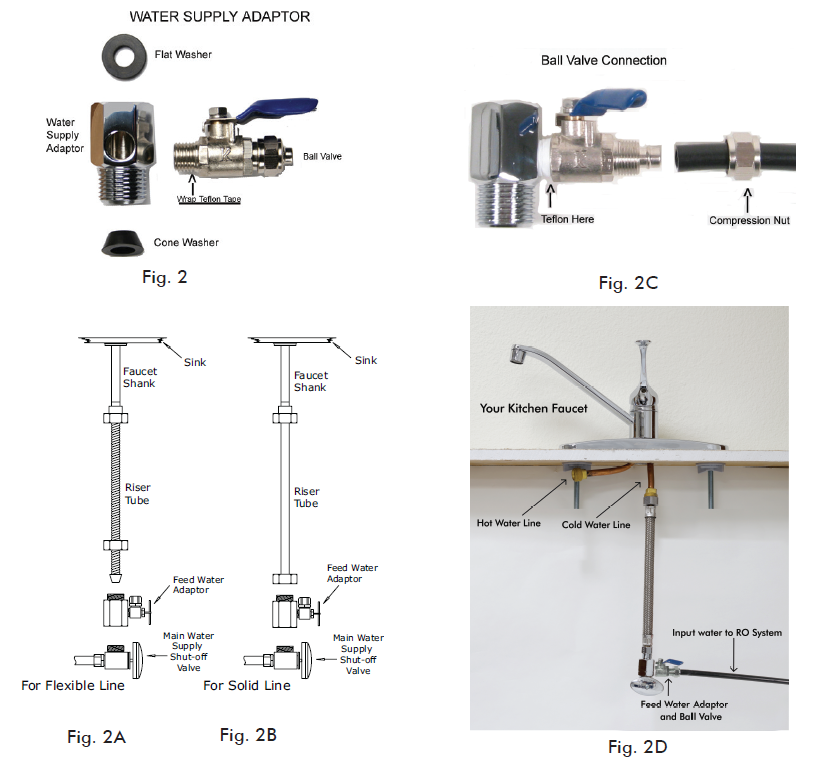
- Ball Valve: See Fig. 2 Screw the Ball Valve onto the Adapter tightly. Apply 5-6 rounds of Teflon tape onto Ball Valve before attaching it to the Adapter. (Note: The “cone washer” is not needed if your water line already has a built in washer).
To Open Ball valve: Turn Handle to the horizontal position. To Close Ball valve: Turn Handle to the vertical position. - Test for leaks at this point: Close the Ball Valve by turning the “handle” to the vertical position, this will shut-off the feed water. Then, turn ON the cold water supply, watch to see if there is water leaking at the connection. If there is leakage, re-examine the connection and try applying more Teflon tape or more tightening at the connections.
Ball Valve: The Feed Water Ball Valve allows you to shut-off feed water to the RO system without shutting off the cold water supply to your sink. When installation is complete, please remember to Open the Ball Valve to let the feed water through.
To open the valve: Turn the “handle” to the horizontal position.
Step 2: Drain Saddle Installation
Note: To avoid annoying drainage noise, mount drain line as low as possible on the vertical tailpiece, or on horizontal tailpiece.
There is constant water pressure “packed” inside the RO system which blocks the waste water from backing-up into the system. So the waste water is “forced-drained”, not “gravity-drained”.
See Fig. 3. The drain saddle assembly should be installed above the trap and on the vertical or horizon- tal tailpiece. To reduce the drainage noise, mount the drain line as low as possible above the trap, or on the horizontal tailpiece.
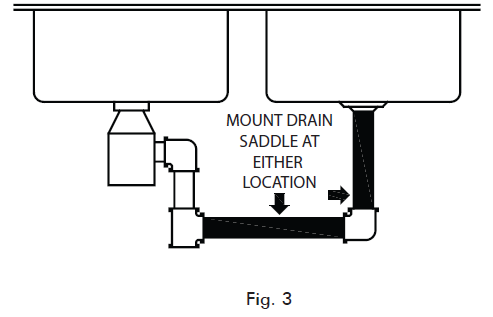
See Fig. 4. Mark the position of the hole on the drain pipe and drill a 1/4” hole through one side of the drain pipe. There is a piece of self-adhesive sponge provided. Glue this sponge to the inside of the saddle, this will cushion any gap between the saddle and the pipe. Make sure the hole on the sponge is thoroughly punched out, and is aligned to the hole on the saddle.

See Fig. 4A, 4B. Make sure to align the drain saddle hole to the drilled hole perfectly. Mis-aligning these two holes will block the waste water and cause membrane damage. Attach the drain saddle to the drain pipe and tighten the two screws.
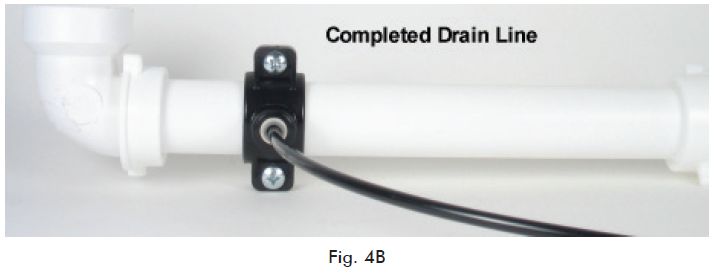
Step 3: Drilling A Hole For The RO Faucet
The RO dispensing faucet can be mounted on the sink, on the counter top, or simply hang at a location where it’s convenient for you to dispense the filtered water. You will need to drill a hole only if you choose to mount the faucet on a surface.
If you don’t need the faucet:
If you don’t need to use the faucet and connect the RO’s output directly to your appliance (Icemaker, coffee maker, soda machines etc.), please make sure your appliance has a shut-off function when it’s full, so that the RO can shut-off properly. Without an “air tight” shut off valve at output end, the RO will not shut-off automatically—it will keep running and quickly deplete the pre-filters and membranes.
Prepare & drill surface for mounting the faucet:
The faucet should be positioned with aesthetics, function and convenience in mind. An ample flat area is required for the faucet base so that the faucet can be drawn down tightly.
Conditions that may be present which could eliminate the need to drill a hole:
- If there is an extra hole already in your sink, covered by a chrome cover, then remove the chrome cover and install the faucet there.
- If there is a spray hose either not functioning or not desired, then remove the spray hose and plug the outlet under the main faucet. Be sure to check if the spray uses a diverter at the base of the spout. If so, remove to avoid trouble later on.
- If the task of drilling is not a feasible option (i.e. the home is rented, a drill is not available etc.), then just connect the faucet and hang it on the cabinet door or wherever that is conve-nient. Be creative!
Safety glasses should be worn to protect your eyes while drilling the faucet hole.
For best results use a 1/2” carbide-tipped masonry drill bit to drill the hole.
- Carefully select the faucet location. Make sure the faucet stud will be accessible from below when the hole is drilled. If space is not available on the upper sink area, the faucet can be lo-cated on the counter top by the edge of the sink. If the counter top is ceramic tile, the method for drilling the hole will be the same as for porcelain sinks.
- For Stainless Steel Sink: Before using a 1/2” carbide drill bit, an indent should be made with a center punch to keep the drill bit from walking. A small pilot hole will also aid the drill bit.
For Porcelain Sink: Porcelain enameled sinks can readily be chipped if care is not exercised when drilling the hole. Before starting the drill motor, apply firm downward pressure on the bit until a crunching occurs. This will help keep the drill bit from walking when starting the hole. A small pilot hole will also aid the drill bit.
Note: Immediately after the hole drilling is done, clean up all metal chips, for metal chips will stain the porcelain!!
Step 4: Mounting The Faucet
Mount the faucet as shown in Fig. 5 below:
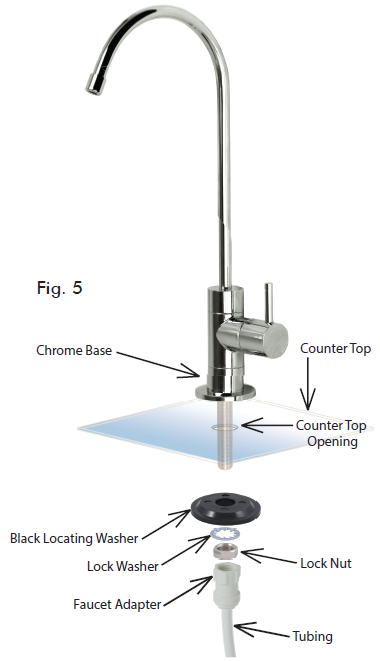
- Connect the Clear output line to the faucet:
Screw the “Faucet Adapter” (provided) onto the faucet base, as shown in Fig. 5 above.
Connect the 3/8” Clear output line to the Faucet Adapter, simply push the line into the Adapter tightly.
NO Teflon tape needed here.
(Note: Discard the un-used nut and sleeve in the faucet kit). - 2 ways to dispense water from faucet: Push down on the black lever to fill a glass of water, or lift up the lever into a locked position to fill a container or to drain the storage tank.
Step 5: Positioning The System
The RO system can stand on the ground or be secured to the wall. The storage tank may be laid on its side if needed. This position does not affect the tank’s performance. If there is not enough room near the RO system, you can put the tank away from the system, up to about 20 feet horizontal without much pressure loss.
Step 6: Connecting The System
There are 4 connections:
- Point A to X: Connect RO to COLD water supply- 3/8” Red tubing.
- Point G to Y: Connect product water from the Last-stage post-carbon filter to tank- 3/8” Yellow tubing *.
- Point H to Z: Connect product water from the Last-stage post-carbon filter output to the dispensing faucet- 3/8” Clear tubing.
- Drain line to W: Connect wastewater line from the RO to drain outlet- 1/4” Black tubing.
How Tank line works: The line from Point G to Y works as a 2-way line; the Product water enters and leaves the tank via this same line.
Make the tubing connections as follows:
To ensure a smooth and correct installation, please connect the water lines in the order outlined below. Refer to Fig.6 for proper point locations.
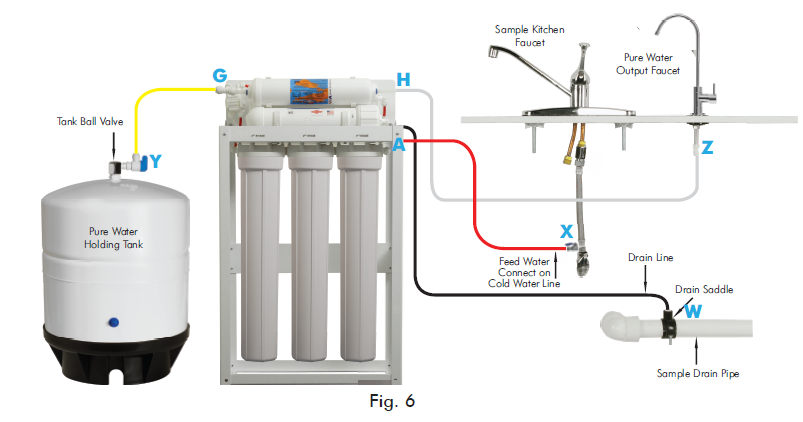
- Point Z Faucet connections:
Tubing color: Clear tubing. Connect the 3/8” CLEAR tubing to the base of the RO faucet.
Fitting type: Quick-Connect fitting. No Teflon tape needed here. - Point X Feed water connection:
Tubing color: Red tubing. Connect the 3/8” RED tubing to the Feed Water Ball Valve.
Fitting type: Metal compression nut fitting. No Teflon tape needed here. - Point W Waste water connection:
Tubing color: Black-tubing. Connect the 1/4” BLACK tubing from the RO to the Drain Saddle.
Fitting type: Quick-Connect fitting on drain saddle. No Teflon tape needed here. - Point A System water inlet (to Stage 1 prefilter) connection:
Tubing color: Red tubing. Connect the 3/8” RED tubing from the Feed Water Ball Valve to the RO’s stage 1 pre-filter.
Fitting type: Quick-Connect fitting here. No Teflon tape needed here.
(UV Light: If your RO has a UV light at Stage-0, then connect the Red tubing to the UV light inlet port). - Point H Stage-5 filtered water to faucet connection:
Tubing color: Clear tubing. Connect the 3/8” CLEAR tubing from the faucet base to the last stage post carbon filter’s outflow end at point H. (See “Flow ” arrow on the filter for flow direction).
Note: Remove the “end plugs” from the filter to open up the ports.
Fitting type: Quick-Connect fitting. No Teflon tape needed here.
(UV Light: If your RO has a UV light at the last stage, then connect the Clear tubing from the UV outlet port to the RO dispense faucet). - Point G Last Stage Post Carbon filter’s T-fitting connection:
Tubing color: Yellow tubing. Connect the 3/8” YELLOW tubing to last stage filter’s T-fitting.
Fitting type: Quick-Connect fitting (remove protective “end plug” from the T-Fitting to open the port). Point Y Tank’s input & output connection:

- Tank Shut-Off Valve Kit: The tank-shut off kit includes 2 parts. A Shut-off valve and a Tank Output Adap-tor. They are NOT tightened when we ship out the tank. At this point, wrap Teflon tape onto threaded parts on the tank adaptor. Put the 2 parts together and tighten them to secure no-leak connection. Please do not over-tighten for it may crack the plastic shut-off valve!
- Put Valve onto Tank: Apply 5-6 wraps of Teflon tape on the tank’s threaded metal stem. Screw the tank valve onto the tank’s stem, as shown in Fig.7 above.
- Connect tank line: Connect the 3/8” yellow tubing from Stage-5 T-fitting to tank’s valve.
Option: Feeding a 2nd Outlet
If you want to connect product water from the RO to a 2nd outlet, you will need:
- One 3/8” T-fitting, preferably the quick-connect type fitting.
- Extra 3/8” tubing long enough to go from the RO system to your 2nd outlet
- Optional: One 3/8” shut-off valve, preferably the quick-connect type.
Before connecting the output water line from Point Z to H, add a T-fitting near point H (see Fig.6A) to divert product water to both the faucet and your 2nd output point.
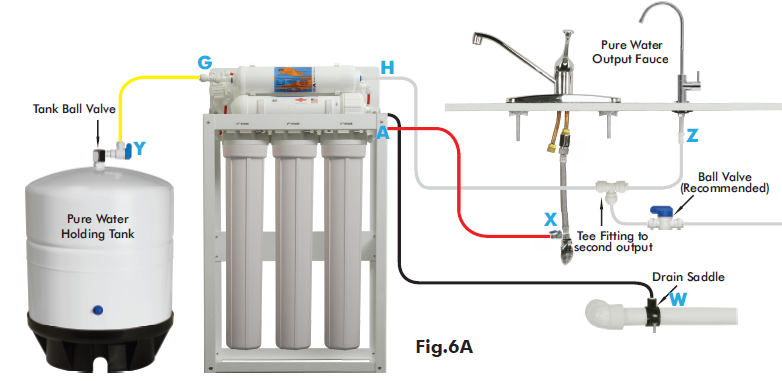
Step 7: System Start-Up
- Turn on feed water: Slowly, turn on your cold water supply. Open the Feed Water Ball Valve to allow the raw water to enter the system. Turn the “handle” to the horizontal position. Check for leaks!
- Turn on tank valve: Turn on the tank’s ball valve to allow water to enter the tank. The tank’s valve is “On” when the valve lever is parallel (in the same direction) with the valve’s outlet (see Fig.7). Check for leaks!
- Wait for tank to fill: Before usage, allow the tank to fill. It takes 2-3 hours to fill tank de-pending on the incoming water pressure.
- Drain Tank: Do not use the first tank of water! Drain it out to flush the system and new filters. Lift the faucet lever up into a locked position to drain tank. Let the tank refill again and the pure water is ready for use.
- Clean up area: Allow the system to run while cleaning up tools and work area.
- Check for leaks! Make sure no water is leaking at joints, fittings, valves, and tubing con-nections.
FILTER CHANGE SCHEDULE
The system requires very little maintenance. Just change the filter cartridges regularly as suggested below. Keep the system sheltered from the weather elements, and run the system within its reasonable output ca-pacity (i.e. allow the system to rest a few hours a day).
Stages-1,2,3 Pre-filters:
- City water usage: Replace the pre-filters at least once a year (annually), or about 8000 gallons of filtered water produced, whichever comes first.
- Well water usage: Replace the pre-filters every 6-8 months depending on well water quality.
- Stage-4 Membrane: City Water: Replace every 3-5 years depending on input water quality, water usage, and prefilter change maintenance.
- Private Well Water: Replace every 2-3 years depending on well water quality, and pre-filter change maintenance.
Membranes Replacement: (2 to 4 membranes depending on RO model)
- Lite-180gpd Model: Two 90gpd membranes, replace both together.
- Lite-240gpd Model: Three 90gpd membranes, replace all 3 together.
- Lite-360gpd Model: Four 90gpd membranes, replace all 4 together.
Post Carbon Filter (Last Stage): Replace every 3-5 years.
It’s best to replace this filter when replacing the stage-4 membrane.
Important! It is important to change the 3 pre-filters timely, at least every 12 months. The pre-filters protect the stage-4 membranes. If they are not changed timely and become over-depleted, the membrane will be damaged and the RO system will be contaminated.
It’s best to use APEC replacement filters. Using “non APEC” and lesser quality filters may clog up the RO system and damage the membrane.
FILTER CHANGE INSTRUCTIONS
How To Replace Stages 1, 2, 3 Pre-Filters:
- Turn OFF cold water supply to RO system. Turn OFF tank’s ball-valve. Lift up RO faucet lever briefly to relief the built-up pressure inside the RO system. This will make opening the hous-ings easier.
- Open housing: Have the RO standing upright. Slip the plastic wrench onto the #1 housing. Looking down from a top view, you should open the housing turning clockwise. If necessary, lay the RO down on the floor to get a better leverage. If the housing is too tight, use a ham-mer and tap on the wrench handle to help turn the wrench.
- Discard 3 used filters, wash housings with mild soap, rinse off. Put 3 new filters into their re-spective housing: sediment filter in stage-1, carbon block filter in stages 2 & 3.
- Close up the housing. Make sure each housing has a black O-ring in the thread groves. Use wrench to tighten each housing.
- Remember: Turn ON the cold water supply and OPEN the tank valve after you fin-ished changing filters!
- Check for leaks!
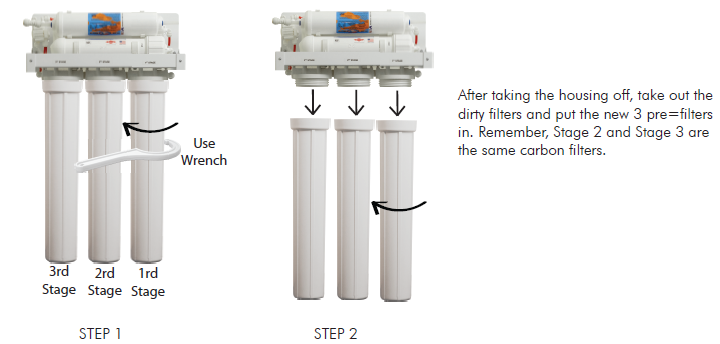
How to Replace Stage-4 Membrane:
There are several membranes (2 to 4 depending on model) provided with your system. Please insert the membrane into each housing one-by-one to prevent mis-connecting the tubing.
- Locate the Membrane housings on the system. See Fig 8
- The number of housing matches with the number of membranes provided. Each housing is labeled as: “MEM-1”, “MEM-2”, “MEM-3”, “MEM-4” depending on your Ro model.
- Start with “MEM-1” housing: Insert the membrane into one housing at a time. Finish up the connection before going onto the next housing. This will prevent confusing the tubing order. Insert membrane: See Fig.8A Remove the tubing from the membrane housing cap. Open the cap. Insert membrane all the way into the housing tightly with the correct side going in first as shown below. The end with 2 black-rings goes in first.
- Close the housing cap. Re-connect the tubing to cap as before. Make sure to connect each color coded tubing to its corresponding (matching) housing. This is important for proper filtra-tion.
- Proceed to insert the other membranes in the same manner.
Note: Make sure the membrane’s end with 2 black-rings goes into housing first!
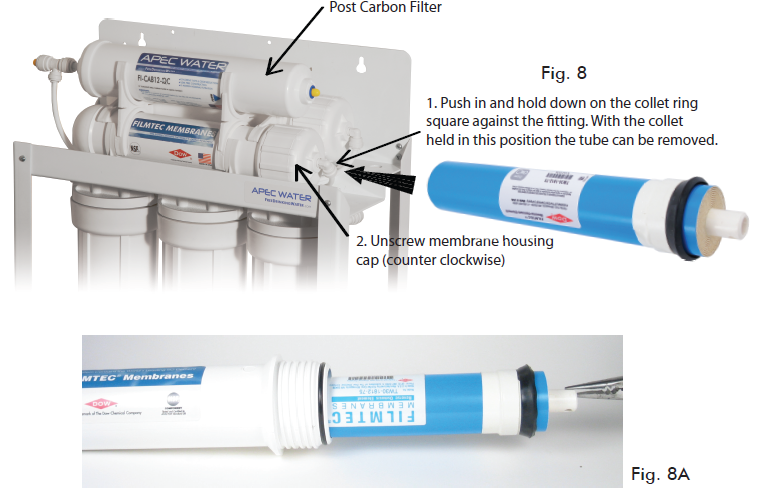
How to Replace Last Stage Post Carbon Filter:
Replace this last filter at the same time you replace the stage-4 membrane.
- Locate the last stage carbon filter. See Fig 8 on Page 16.
- Remove the OLD filter: Disconnect the input 3/8” tubing at Point G. and output 3/8” tubing at Point H. Discard the old filter. (See Fig.6 on Page 10)
To disconnect: Push in and hold down on the collet ring square against the fitting. With the collet held in this position the tubing can be removed. See Fig.1B on page 3. - Remove the 2 end plugs from the new filter to open up the parts.
- Reconnect the input and output tubing. Make sure the “Flow ” on the filter is pointing to the pure water output direction.
Setup Guide
To set up the APEC Water Reverse Osmosis Water Filtration system,
- Start by turning off the cold water supply under the sink. Disconnect the cold water line from the supply valve and attach it to the inlet of the RO system.
- Next, connect the output of the RO system to the faucet provided. Ensure all connections are secure and leak-free.
- Mount the system under the sink, making sure it is level and accessible for future maintenance.
- Once installed, turn on the cold water supply and check for leaks. Allow the system to flush for about 30 minutes before using it to ensure optimal performance.
Troubleshooting
- If you experience slow water flow, it may be due to a clogged RO membrane or filters.
- Regular maintenance, such as changing filters every 6-12 months, can prevent these issues.
- Always refer to the user manual for specific troubleshooting instructions and safety warnings.
APEC Water Reverse Osmosis Water Filtration Pros & Cons
Pros
- Highly effective in removing contaminants
- Easy to install and maintain
- Compact design suitable for under-sink installation
- Lead-free chrome faucet included
- NSF certified for quality and safety
- Affordable compared to other high-quality RO systems
Cons
- Generates wastewater during the filtration process
- Requires periodic filter replacements
- May reduce water pressure slightly
- Installation may require some plumbing knowledge
Customer Reviews
Customers have generally praised the APEC Water Reverse Osmosis Water Filtration system for its effectiveness in improving water taste and quality. Many reviewers appreciate the ease of installation and the comprehensive instructions provided. However, some users have noted that the system generates a significant amount of wastewater and requires regular maintenance to ensure optimal performance.
Warranty
APEC takes pride in selling a superb line of products, including this reverse osmosis system (“Product”). As such, APEC expressly warrants to the original purchaser that, for a period of one (1) year from the date of purchase, the Product will be reasonably free of defects in materials and workmanship. Within that one (1) year period from the original purchase, APEC will, at its option, repair or replace the Product without charge, or refund the cost of the Product, if the Product fails or does not perform as warranted solely due to a manufacturing defect within the warranty period, subject to the limitations and exclusions set forth in this Limited Product War-ranty. This Limited Product Warranty only applies when the Product is used, stored, handled, fabricated and/or installed in the manner recommended by APEC in the Installation Instruction & Owner’s Manual (“Manual”).
Faqs
What is the process of reverse osmosis in the APEC?
How often should I replace the filters in my APEC Water Reverse Osmosis Water Filtration?
Can I install the APEC Water system myself?
Why does my APEC RO system produce so much wastewater?
Is the APEC Water NSF certified?
How long does it take to set up the APEC Water RO system?
Can I use this system with well water?
Why is my water pressure low after installing the APEC Water Reverse Osmosis Water Filtration?
Does this system remove fluoride from water?
How do I know if my APEC RO system is working correctly?
Leave a Comment
